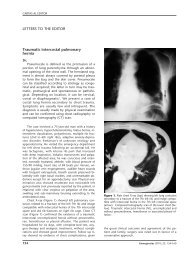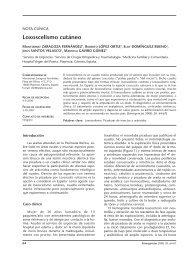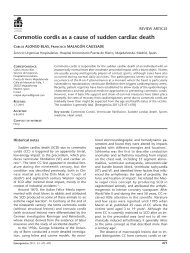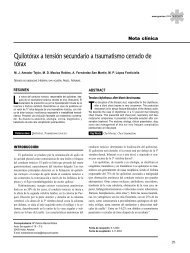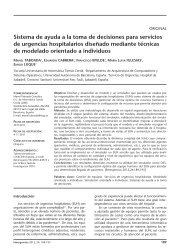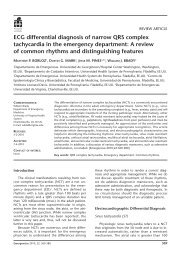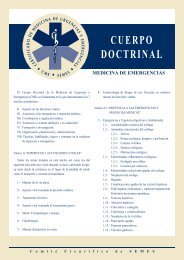Secuencia de intubación rápida - Semes
Secuencia de intubación rápida - Semes
Secuencia de intubación rápida - Semes
You also want an ePaper? Increase the reach of your titles
YUMPU automatically turns print PDFs into web optimized ePapers that Google loves.
SECUENCIA DE INTUBACIÓN RÁPIDA<br />
68 Subhas K, Appleby J. Traumatic brain injury: initial resuscitation and<br />
transfer. Anaesth Intensive Care. 2011;12:201-3.<br />
69 Hayward E, Hunt K. Clinical neuroprotection and secondary neuronal<br />
injury mechanisms. Anaesth Intensive Care. 2011;12:198-200.<br />
70 San-Juan D, Chiappa K, Cole A. Propofol and the electroencephalogram.<br />
Clin Neurophysiol. 2010;121:998-1006.<br />
71 García Vicente E, Sandoval Almengor JC, Díaz Caballero LA, Salgado<br />
Campo JC. Ventilación mecánica invasiva en EPOC y asma. Med Intensiva.<br />
2011;35:288-98.<br />
72 Hanna S, Ahmad F, Pappas AL, Mikat-Stevens M, Jellish WS, Kleinman B, et<br />
al. The effect of propofol/remifentanil rapid-induction technique without<br />
muscle relaxants on intraocular pressure. J Clin Anesth. 2010;22:437-42.<br />
73 Salman A, Salman M, Saricaoglu F, Akinci SB, Aypar U. Pain on injection<br />
of propofol: a comparison of methylene blue and lidocaine. J<br />
Clin Anesth. 2011;23:270-4.<br />
74 Muller AE, Huisman I, Roos PJ, Rietveld AP, Klein J, Harbers JBM, et<br />
al. Outbreak of severe sepsis due to contaminated propofol: lessons<br />
to learn. J Hosp Infect. 2010;76:225-30.<br />
75 Mallory M, Baxter A, Yanosky D, Cravero J. Emergency physician–administered<br />
propofol sedation: a report on 25,433 sedations from the pediatric<br />
sedation research consortium. Ann Emerg Med. 2011;57:462-8.<br />
76 Power KN, Flaatten H, Gilhus NE, Engelsen BA. Propofol treatment in<br />
adult refractory status epilepticus. Mortality risk and outcome. Epilepsy<br />
Res. 2011;94:53-60.<br />
77 Hickey K, Martin D, Chuidian F. Propofol-induced seizure-like phenomena.<br />
J Emerg Med. 2002;29:447-9.<br />
78 Laquay N, Prieur S, Greff B, Meyer P, Orliaguet G. Le syndrome <strong>de</strong><br />
perfusion du propofol. Ann Fr Anesth Reanim. 2010;29:377-86.<br />
79 Farooq K, Hunter J. Neuromuscular blocking agents and reversal<br />
agents. Anaesth Intensive Care. 2011;12:266-70.<br />
80 Perry JJ, Lee JS, Sillberg VAH, Wells GA. Rocuronium versus succinylcholine<br />
for rapid sequence induction intubation. Cochrane Database<br />
of Systematic Reviews 2008, Issue 2. Art. No.: CD002788.<br />
DOI:10.1002/14651858.CD002788.pub2.<br />
81 Caldwell J. The Continuing Search for a Succinylcholine Replacement.<br />
Anesthesiology. 2004;100:763-4.<br />
82 Pollard B. Neuromuscular blocking agents and reversal agents.<br />
Anaesth Intensive Care. 2005;6:189-92.<br />
83 Orebaugh S. Succinylcholine: adverse effects and alternatives in<br />
emergency medicine. Am J Emerg Med. 1999;17:715-21.<br />
84 Booij L. Is succinylcholine appropriate or obsolete in the intensive<br />
care unit? Crit Care. 2001;5:245-6.<br />
85 Pérez-Moreno J, Rodríguez M, González P, Sánchez-Elduayen MT.<br />
Dosificación actual <strong>de</strong> la succinilcolina. Rev Esp Anestesiol Reanim.<br />
2007;54:54-5.<br />
86 Hernán<strong>de</strong>z-Palazón J, Noguera-Velasco J, Falcón-Araña L, Doménech-<br />
Asensi P, Burguillos-López S, Nuño <strong>de</strong> la Rosa-Carrillo V. La precurarización<br />
con rocuronio previene las fasciculaciones y los cambios bioquímicos<br />
tras la administración <strong>de</strong> succinilcolina. Rev Esp Anestesiol<br />
Reanim. 2004;51:184-9.<br />
87 Zimmerman A, Funk K, Tidwell J. Propofol and alfentanil prevent the<br />
increase in intraocular pressure caused by succinylcholine and endotracheal<br />
intubation during a rapid sequence induction of anesthesia.<br />
Anesth Analg. 1996;83:814-7.<br />
88 Turan A, Mendoza M, Gupta S. Consequences of succinylcholine administration<br />
to patients using statins. Anesthesiology. 2011;115:28-35.<br />
89 Lee C. Succinylcholine should be avoi<strong>de</strong>d in patients on statin therapy.<br />
Anesthesiology. 2011;115:6-7.<br />
90 Chamorro C, Romera MA, Pardo C, Silva JA. Nuevos bloqueadores<br />
neuromusculares. Med Intensiva. 2001;25:340-3.<br />
91 Mallon WK, Keim SM, Shoenberger JM, Wall RM. Rocuronium vs<br />
succinylcholine in the emergency <strong>de</strong>partment: a critical appraisal. J<br />
Emerg Med. 2009;37:183-8.<br />
92 Lee C, Katz R. Clinical implications of new neuromuscular concepts and<br />
agents: So long, neostigmine! So long, sux! J Crit Care. 2009;24:43-9.<br />
93 Seupaul R, Jones J. Does succinylcholine maximize intubating conditions<br />
better than rocuronium for rapid sequence intubation? Ann<br />
Emerg Med. 2011;57:301-2.<br />
94 Yang L, Keam S. Sugamma<strong>de</strong>x. A review of its use in anaesthetic<br />
practice. Drugs. 2009;69:919-42.<br />
95 Ren W, Jahr J. Reversal of neuromuscular block with a selective relaxant-binding<br />
agent: sugamma<strong>de</strong>x. Am J Ther. 2009;16:295-9.<br />
96 McDonagh D, Benedict P, Kovac A, Drover D, Brister N, Morte J, et<br />
al. Efficacy, safety, and pharmacokinetics of sugamma<strong>de</strong>x for the<br />
reversal of rocuronium-induced neuromuscular blocka<strong>de</strong> in el<strong>de</strong>rly<br />
patients. Anesthesiology. 2011;114:318-29.<br />
97 Lee C, Jahr J, Candiotti K, Warriner B, Zornow M, Naguib M. Reversal<br />
of profound neuromuscular block by sugamma<strong>de</strong>x administered<br />
three minutes after rocuronium. A Comparison with Spontaneous<br />
Recovery from Succinylcholine. Anesthesiology. 2009;110:1020-5.<br />
98 Strayer R. Rocuronium versus succinylcholine: cochrane synopsis reconsi<strong>de</strong>red.<br />
Ann Emerg Med. 2011;58:217-8.<br />
99 Marsch S, Steiner L, Bucher E, Pargger H, Schumann M, Aebi T, et<br />
al. Succinylcholine versus rocuronium for rapid sequence intubation<br />
in intensive care: a prospective, randomized controlled trial. Crit.<br />
Care. 2011;15:R199.<br />
100 Souto Mata F, Martínez Melgar J, Katcher W, Rama Sorribas JM, Paz<br />
Esquete J. Experiencia con el uso <strong>de</strong> rocuronio en la intubación<br />
orotraqueal en una unidad <strong>de</strong> soporte vital avanzada móvil (USVA).<br />
Puesta al día en urgencias, emergencias y catástrofes. 2009;9:1-7.<br />
101 Carrillo-Esper R, Vinay-Ramírez B, Bahena A. Maniobra <strong>de</strong> BURP. Revista<br />
Mexicana <strong>de</strong> Anestesiología. 2008;31:63-5.<br />
102 Paal P, Herff H, Mitterlechner T, Goe<strong>de</strong>ckeb A V, Brugger H, Lindner<br />
K, et al. Anaesthesia in prehospital emergencies and in the emergency<br />
room. Resuscitation. 2010;81:148-54.<br />
103 Vanner R. Cricoid pressure. Int J Obstet Anesth. 2009;18:103-5.<br />
104 Harris T, Ellis D, Foster L, Lockey D. Cricoid pressure and laryngeal manipulation<br />
in 402 pre-hospital emergency anaesthetics: Essential safety measure<br />
or a hindrance to rapid safe intubation? Resuscitation. 2010;81:810-6.<br />
105 Ellis D, Harris T, Zi<strong>de</strong>man D. Cricoid pressure in emergency <strong>de</strong>partment<br />
rapid sequence tracheal intubations: a risk-benefit analysis.<br />
Ann Emerg Med. 2007;50:653-65.<br />
106 Rigini N, Boaz M, Ezri T, Evron S, Jackobashvilli S, Izakson A. Prompt<br />
correction of endotracheal tube positioning after intubation prevents<br />
further inappropriate positions. J Clin Anesth. 2011;23:367-71.<br />
107 Wood S, Winters M. Care of the intubated emergency <strong>de</strong>partment<br />
patient. J Emerg Med. 2011;40:419-27.<br />
108 Schram W, Jesenko R, Bartune A, Gilly H. Effects of cisatracurium<br />
on cerebral and cardiovascular hemodynamics in patients with severe<br />
brain injury. Act Anaesthesiol Scand. 1997;41:1319-23.<br />
109 De Boer H. Neuromuscular transmission: new concepts and agents.<br />
J Crit Care. 2009;24:36-42.<br />
Rapid sequence intubation<br />
Parrilla Ruiz FM, Aguilar Cruz I, Cár<strong>de</strong>nas Cruz D, López Pérez L, Cár<strong>de</strong>nas Cruz A<br />
Establishing an airway is a stressful, high-risk maneuver for a physician. The rapid sequence intubation procedure is used<br />
to minimize complications, achieve a high success rate, and reduce stress. The sequence involves the following 7 steps:<br />
1) planning and preparation, 2) preoxygenation, 3) pretreatment, 4) sedation and neuromuscular relaxation, 5)<br />
protection and positioning, 6) tube placement insi<strong>de</strong> the trachea with proof, and 7) postintubation management. This<br />
review <strong>de</strong>scribes the steps and explains how to carry them out. [Emergencias 2012;24:397-409]<br />
Key words: Rapid sequence intubation. Tracheal intubation. Opioids. Hypnotics. Neuromuscular blocking agents.<br />
Emergencias 2012; 24: 397-409 409



